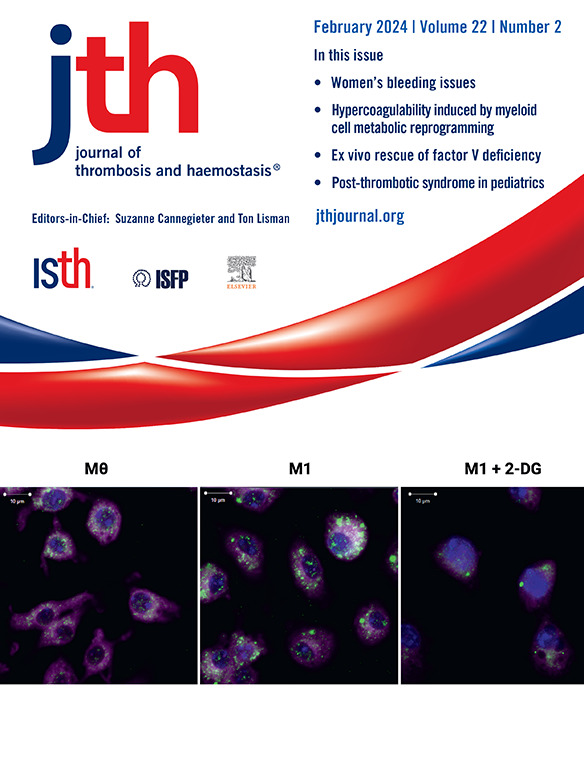Fibrin film on clots is increased by hematocrit but reduced by inflammation: implications for platelets and fibrinolysis
IF 5.5
2区 医学
Q1 HEMATOLOGY
引用次数: 0
Abstract
Background
Blood clot formation, triggered by vascular injury, is crucial for hemostasis and thrombosis. Blood clots are composed mainly of fibrin fibers, platelets, and red blood cells (RBCs). Recent studies show that clot surfaces also develop a fibrin film, which provides protection against wound infection and retains components such as RBCs within the clot. However, the role of fibrin films in thrombi remains poorly understood.
Objectives
To explore the relationship between fibrin films and inflammation, RBC concentration, platelets, and fibrinolysis activity.
Methods
We used laser scanning confocal and scanning electron microscopy, enzyme-linked immunosorbent assay, and turbidity and fibrinolysis assays to investigate the interactions between fibrin film and inflamed endothelium, RBCs, platelets, and fibrinolysis.
Results
We found that plasma clots forming on top of inflamed endothelial cells show less fibrin film coverage and are characterized by higher fiber density and shorter lag time compared with control cells. Blood clots formed under conditions of high hematocrit showed significantly more fibrin film coverage than low hematocrit clots. We found that platelet adhesion was significantly reduced on clots with film compared with clots without film even when platelets were preactivated. Fibrinolysis was faster in clots without film than in clots with film, partly due to reductions in plasmin generation.
Conclusion
Our findings indicate that reductions in fibrin film formation under thromboinflammatory conditions support continued clot growth through effects on increased platelet adhesion and activation. On the other hand, increased fibrin film impairs fibrinolysis. These data show a multifaceted role of the fibrin film in clot growth and stability.
血块上的纤维蛋白膜因红细胞压积而增加,但因炎症而减少:对血小板和纤维蛋白溶解的影响。
背景:血管损伤引发的血凝块形成是止血和血栓形成的关键。血凝块主要由纤维蛋白纤维、血小板和红细胞组成。最近的研究表明,凝块表面也会形成一层纤维蛋白膜,它可以保护伤口免受感染,并保留凝块内的红细胞等成分。然而,纤维蛋白膜在血栓中的作用仍然知之甚少。目的:探讨纤维蛋白膜与炎症、红细胞浓度、血小板及纤溶活性的关系。患者/方法:采用激光共聚焦扫描电镜、扫描电镜、酶联免疫吸附试验、浊度测定和纤维蛋白溶解试验研究纤维蛋白膜与炎症内皮、红细胞、血小板和纤维蛋白溶解的相互作用。结果:我们发现,与对照细胞相比,在炎症内皮细胞顶部形成的血浆凝块显示出较少的纤维蛋白膜覆盖,并且具有更高的纤维密度和更短的滞后时间。在高红细胞压积条件下形成的血凝块比低红细胞压积条件下形成的血凝块显示出明显更多的纤维蛋白膜覆盖。我们发现,即使预先激活血小板,有膜凝块上的血小板粘附也比没有膜凝块上的血小板粘附明显减少。无膜凝块的纤溶速度比有膜凝块快,部分原因是减少了纤溶酶的产生。结论:我们的研究结果表明,在血栓炎症条件下,纤维蛋白膜形成的减少通过增加血小板粘附和活化的作用支持血栓的持续生长。另一方面,增加的纤维蛋白膜损害了纤维蛋白溶解。这些数据显示了纤维蛋白膜在凝块生长和稳定性中的多方面作用。
本文章由计算机程序翻译,如有差异,请以英文原文为准。
求助全文
约1分钟内获得全文
求助全文
来源期刊
CiteScore
24.30
自引率
3.80%
发文量
321
审稿时长
1 months
期刊介绍:
The Journal of Thrombosis and Haemostasis (JTH) serves as the official journal of the International Society on Thrombosis and Haemostasis. It is dedicated to advancing science related to thrombosis, bleeding disorders, and vascular biology through the dissemination and exchange of information and ideas within the global research community.
Types of Publications:
The journal publishes a variety of content, including:
Original research reports
State-of-the-art reviews
Brief reports
Case reports
Invited commentaries on publications in the Journal
Forum articles
Correspondence
Announcements
Scope of Contributions:
Editors invite contributions from both fundamental and clinical domains. These include:
Basic manuscripts on blood coagulation and fibrinolysis
Studies on proteins and reactions related to thrombosis and haemostasis
Research on blood platelets and their interactions with other biological systems, such as the vessel wall, blood cells, and invading organisms
Clinical manuscripts covering various topics including venous thrombosis, arterial disease, hemophilia, bleeding disorders, and platelet diseases
Clinical manuscripts may encompass etiology, diagnostics, prognosis, prevention, and treatment strategies.

 求助内容:
求助内容: 应助结果提醒方式:
应助结果提醒方式:


